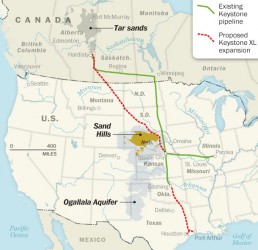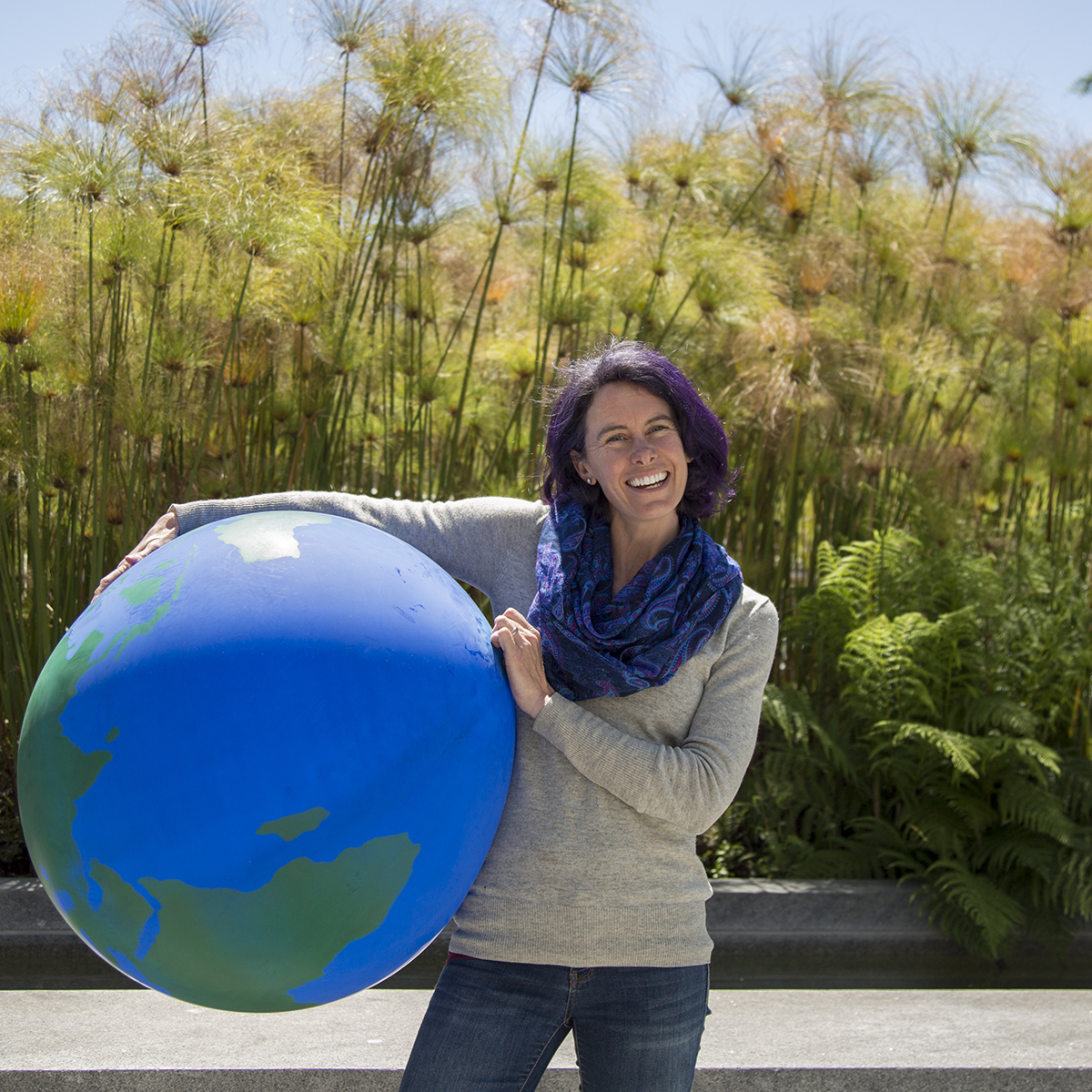A Dummy’s Guide to Keystone XL
Rebecca Anderson
|February 12, 2013
I admit it: For a long time, I didn’t get the Keystone XL pipeline. Where is it? What’s it for? It’s bad – why? Why are people so fired up about it?
So I did a little research. And then a little more. This is the result – consider it like a Dummy’s Guide to Keystone XL – all the things you wanted to know, but were afraid to ask.
Let’s run through the questions:
Where is it?
Well, it’s not… yet. But it is. Sections of it in Texas are being built already. And the reason it’s called Keystone XL is because there’s already a plain ol’ Keystone pipeline, bringing the very same tar sands oil into the U.S. It goes from Hardisty, Alberta (that’s Canada) to two spots in Illinois and one spot in Oklahoma where the oil gets refined (and then shipped out to Midwest gas stations).
This blew me away: There already is an operational Keystone pipeline, pumping 500,000 barrels of oil a day from the tar sands to the U.S. for us to consume. I had no idea! (I’ll get to the tar sands in a bit, but suffice it to say they are in many ways not the cleanest energy source, even for a fossil fuel.)
Keystone XL refers to two more proposed phases of the pipeline: a shorter cut-off route from the source in Alberta through Montana, South Dakota and Nebraska (then linking up with the current pipeline) and an extension headed south from Oklahoma through Texas, all the way to the coast, where the oil could be refined and exported.
If all this still sounds confusing, check it out on the map.
What’s it for?
The purpose of the pipeline is to transport oil from a place called the tar sands in Canada through the U.S. to be exported around the world. This is one criticism of the pipeline: that it’d be passing through the U.S. but we wouldn’t get the benefits of this oil ourselves. (Although for our climate, we’d be better off just leaving this oil in the ground anyway.)
Why’s it bad?
There are a lot of people out there who say it’s not. Building the pipeline will create jobs (though the number and how long they will last are in debate) and tap into a valuable energy source that the world needs. But from a climate, as well as an environmental perspective, there are some serious reservations about Keystone XL.
First, we gotta distinguish between the climate concerns and the environmental concerns.
Environmental concerns
The pipeline was originally proposed to cross a part of Nebraska called the Sandhills, an environmentally-sensitive (and beautiful) area that is a key part of the Ogalala aquifer and habitat for migrating birds. The Ogalala aquifer supplies drinking water for two million people and $20 billion in agriculture. If there were an oil spill that got into this key water supply, it’d be a disaster to people, animals and our water supply that would be very hard to clean up. TransCanada (the company that’s building Keystone XL) has since proposed a route around the Sandhills, but would still pass over the aquifer. Oil spills from pipelines happen; we know that. TransCanada itself has had several of them in the past.
A second environmental concern is the air quality at the southern end of the pipeline where the oil would be refined. Air quality is already poor in these communities, which are generally low-income communities and home to a greater proportion of people of color than other areas. Emissions from oil refineries are linked to serious health issues such as heart and lung disease, asthma, cancer and decreased life expectancy. Tar sands oil itself is also higher in pollutants such as sulfur and nitrogen that form smog and heavy metals like lead, mercury and arsenic.
This brings us to the key topic of both a climate and an environmental concern: the tar sands themselves. This is not the kind of oil you picture shooting up from a Texas oil well. Quite the opposite: an extremely thick, viscous substance called bitumen, mixed into sand. Hence the name tar sands. The tar is complicated and costly to extract: either open-pit mining is needed or, worse, something called in-situ extraction where steam is pumped underground to heat up the bitumen enough to get it to flow out. The steam that gets this tarry oil to flow comes from burning the cleanest fossil fuel, natural gas, leading to the term “turning gold into lead.”
Tar sands mining itself is environmentally destructive, involving clear cutting and pollution into local air and water, but it’s also a nightmare for the climate.
Climate concerns
It takes a lot of energy to get this tar out of the ground and turn it into the kind of oil that can travel through a pipeline. Three to four times the carbon emissions of conventional oil to get it out, plus even more for the in-situ style of mining. Which is why until recently it wasn’t even worth the effort to mine it.
So, there’s the carbon factor of mining the tar sands and then there’s the carbon contained in the tar sands themselves that would be added to the atmosphere, raising the level of CO2 and furthering climate change. In the tar sands as a whole, there’s enough carbon (~230 gigatons) to increase CO2 by ~100 ppm. That’s a lot. Probably way more than would ever be emitted just by Keystone XL alone.
Considering just the pipeline itself over its expected 50-100 year lifetime and assuming the tar sands oil would be replacing more conventional oil that we’d need to burn anyway, the estimate is more like a total increase in CO2 of less than 1 ppm.
That might not sound like much. But is this really the direction we want to head in for our energy future? Sticky, viscous tar that’s harmful to the climate, dangerous to the environment it passes through and bad for us, whether we live near a refinery or not?
I think not. Keystone XL is a step in the wrong direction, a long-term commitment to a dirty energy source. We know that as a country and as a globe, we need to move ourselves away from fossil fuels and instead focus on being smarter and cleaner about our energy sources. Keystone XL isn’t clean or smart. We deserve better than this from our government.
That’s why, for better or worse, Obama’s decision on Keystone XL, now not expected until at least June, has become such a big deal. It’s a litmus test of his commitment to tackling climate change. And as this symbol of what Obama may or may not do on climate in the next four years, a whole lot more than a pipeline could hang in the balance.
That’s why I’m proud of the students, teachers and ACE staff taking part in the largest climate rally in history: in DC and in solidarity rallies in Los Angeles and San Francisco. They’re using their energy, their voices and their feet to bring more attention to the issue and to ask the government for action. It’s bigger than Keystone – but Keystone is big enough.
Join our Youth Action Network
More Blog Posts

Our Climate Wins Were on Display at the State of the Union
Today, the Biden Administration temporarily halted all pending decisions on 17 Liquefied “Natural” Gas (LNG) projects across the Gulf South.
Read More
ACE Honored As An Anthem Awards Finalist
Action for the Climate Emergency (ACE) announced today that it won Bronze in Best Use of AI at the 3rd …
Read More
BREAKING: Biden Halts LNG Export Expansion
Today, the Biden Administration temporarily halted all pending decisions on 17 Liquefied “Natural” Gas (LNG) projects across the Gulf South.
Read More

